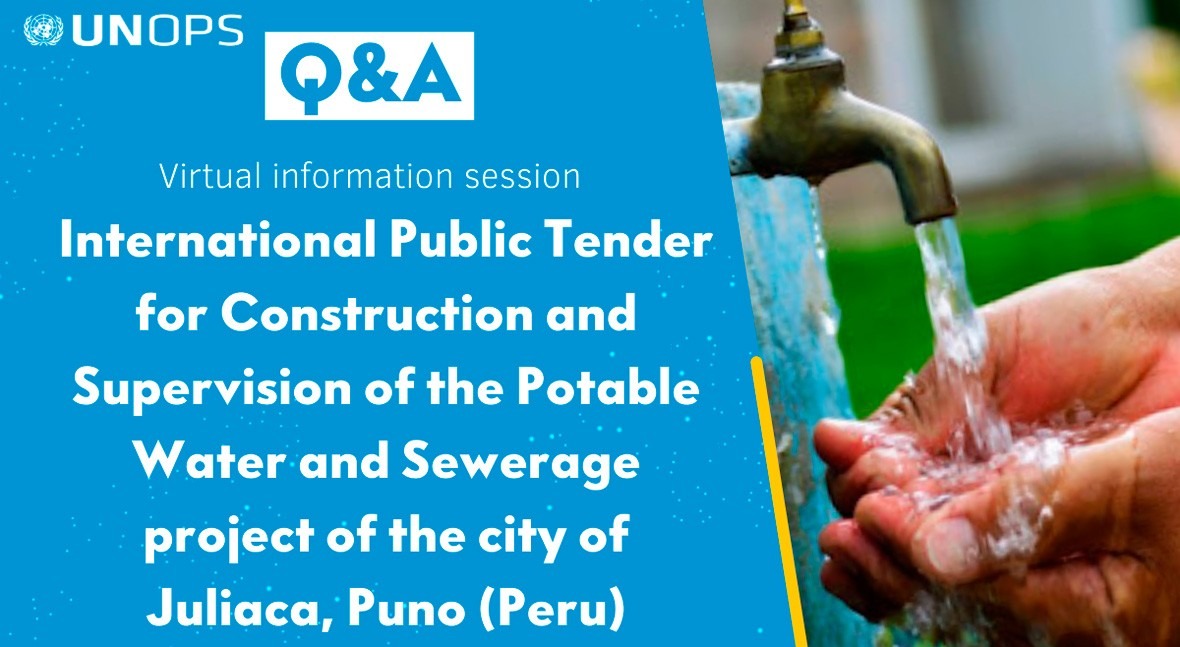The National Infrastructure Plan for Competitiveness represents the first effort of the Peruvian Government to define a vision and objectives to close infrastructure gaps.
To this end, 52 projects have been prioritized and investments have been articulated to boost growth, competitiveness and development in the country, from a sectoral and territorial perspective, including the project "Expansion and improvement of drinking water and sewerage services in the city of Juliaca - Puno", which will have a positive impact on people's health and will contribute to improving the conservation of Lake Titicaca.
As part of its assistance to the Peruvian government, UNOPS has signed a cooperation agreement to tender the construction and supervision of this important project. Details will be provided in the virtual briefing "International public tender for the construction and supervision of the drinking water and sewerage project of Juliaca, Puno" that will take place on December 7; you can register at this link.
What will be tendered?
The contruction and supervision of Phase I of the project "Expansion and improvement of drinking water and sewerage services in the city of Juliaca – Puno”, in the Lake Titicaca basin, in southern Peru. The works will last 974 calendar days (33 months) + 180 calendar days (6 months) for commissioning.
The Ministry of Housing, Construction and Sanitation of Peru (MVCS) approved the technical dossier for the project to expand and improve drinking water and sewerage services in the city of Juliaca, province of San Román, Puno.
More than S/1200 million (about US$295 million) will be invested in the comprehensive project for Juliaca, which is part of the National Infrastructure Plan for Competitiveness (PNIC), and will benefit more than 400,000 residents.
Given the magnitude of the project, its technical dossier was divided into two phases. The construction budget for Phase I is S/ 1,051,528,689 (about US$250 million) and includes the expansion of the drinking water and sewerage systems, a new water source and a new drinking water treatment plant. The Juliaca sanitation system will be complemented by a wastewater treatment plant, part of the Wastewater Treatment System for the Lake Titicaca Basin mega-project, known as PTAR Titicaca, which will contribute to the lake's gradual clean-up, and to the efficient treatment of wastewater from ten cities and towns in the Puno region. This is a private co-financed initiative granted by the Peruvian government to the company Operadora Ecológica del Titicaca (Opeti) as a public-private partnership (PPP).
Phase II of the technical dossier for the project, which also includes the improvement of water and sewerage networks, is currently being prepared and should be completed by the end of 2021.
What does the project involve?
The drinking water system planned in Phase I has the following components:
- Abstraction works: they include a weir and an intake located on the right bank of the Cabanillas River.
- Primary pipeline LCP-01, from intake to the drinking water treatment plant (DWTP), L=2.67 km and two (02) air valves.
- Drinking water treatment plant with a design flow rate (Q) of 1,450 l/s and a maximum Q of 1.6 m3/s.
- Primary pipeline LCP-02, from DWTP to diversion chambers and/or reservoirs; L=47.62 km, 32 air valves and 21 bleed valves.
- Diversion chambers in LCP-02: two (02) planned units, one in Cabanillas and another one in Cabana.
- Shut-off valves in LCP-01: five (05) planned units.
- Secondary pipeline LCS: L = 30.16 km
- Diversion chambers in secondary pipelines: 12 units to planned and existing reservoirs.
- Planned reservoirs: six (06) elevated reservoirs REP and three (03) supported reservoirs RAP which supply seven service zones.
- Conveyance pipelines: 10.71 Km, 3 air valves and 8 bleed valves.
- Sector entry chambers: 16 units associated with seven reservoirs; each with 4 underground chambers: control chamber, metering chamber, SCADA chamber and air valve chamber.
- Secondary networks in seven (07) service zones, L = 471.14 km, incorporating air, bleed and gate valves.
- Household connections: a total of 30,787 connections.
- New: 23,200 connections.
- Replacement: 1,150 connections.
- Improvement: 6,437 connections.
- Micro-metering: a total of 30,787 meters.
The sewerage system planned in Phase I has the following components:
- Drainage areas: 16 areas.
- Wastewater pumping stations: 16 units, each with wet chamber, dry chamber, valve chamber, metering chamber and its different systems.
- Wastewater pumping lines: 16 units.
- Main sewers: L = approximately 11 km.
- Secondary sewer network: L = approximately 423.16 km.
- Household sewer connections: 23,648 connections.
- New: 22,603 connections.
- Improvement: 1,045 connections.
Which institutions are involved?
As part of its assistance to the Peruvian Government, UNOPS has signed a cooperation agreement with the National Urban Sanitation Program (PNSU), under the Ministry of Construction, Housing and Sanitation (MCVS), to tender the construction and supervision of this important project.
Upon completion of the work, it will be transferred to the municipal service provider SEDAJULIACA S.A., which will be in charge of operation and maintenance.
What will this project mean?
The city of Juliaca, capital of the province of San Roman, located in the department of Puno, has a population of more than 150,000 people in the urban area and 390,000 people including surrounding areas (215 housing developments in total).
Only half of the population has access to drinking water and sewerage services through the public network managed by the municipal company SEDAJULIACA S.A. and with a continuity of service of only 4 to 7 hours per day. The rest of the population uses untreated fresh water from artesian wells or private open-pit wells, which are operated by hand.
The purpose of this project is to promote the sustainability of services, expand coverage and improve the quality of drinking water and sewerage services in terms of quantity, timeliness and sufficient continuity, facilitating access to basic drinking water services and thus improving the quality of life of the residents of this important city in the Titicaca basin (390,856 people, 215 housing developments).
What are the requirements for companies interested in participating?
- They should register as a supplier with the United Nations Global Marketplace (UNGM).
- Watch for the publication of the call for prequalification and this tender.
- Experience in this type of work.
- They must have initiated the registration process with the Peruvian National Registry of Suppliers at the time of submitting the bid and be registered at the time of signing the contract.
To receive all the information, we recommend you register at this link and participate in the information session to be held on December 7.




